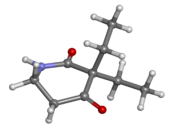Piperidione
Tools
Actions
General
Print/export
Print/export
In other projects
From Wikipedia, the free encyclopedia
This is an old revision of this page, as edited by DMacks (talk | contribs) at 06:23, 23 June 2020 (Remove malformatted |molecular_weight= when infobox can autocalculate it, per Wikipedia talk:WikiProject Pharmacology#Molecular weights in drugboxes (via WP:JWB)). The present address (URL) is a permanent link to this revision, which may differ significantly from the current revision.
Revision as of 06:23, 23 June 2020 by DMacks (talk | contribs) (Remove malformatted |molecular_weight= when infobox can autocalculate it, per Wikipedia talk:WikiProject Pharmacology#Molecular weights in drugboxes (via WP:JWB))
 | |
 | |
| Clinical data | |
|---|---|
| Trade names | Ascron, Dihyprylon, Dihyprylone, Sedulon, Tusseval |
| ATC code | |
| Identifiers | |
| |
| CAS Number |
|
| PubChem CID | |
| ChemSpider |
|
| UNII | |
| CompTox Dashboard (EPA) | |
| ECHA InfoCard | 100.000.909 |
| Chemical and physical data | |
| Formula | C9H15NO2 |
| Molar mass | 169.224 g·mol−1 |
| 3D model (JSmol) | |
| |
| |
| | |
Piperidione (trade name Sedulon) is a sedative drug, structurally related to methyprylon and pyrithyldione. It used to be marketed by Roche as a cough medicine available in liquid form.[1][2][3]
See also
References
- ^ Wolff PO (1949). "On pethidine and methadone derivatives". Bulletin of the World Health Organization. 2 (2): 193–204. PMC 2553950. PMID 15409516.
- ^ Jacobs S (October 1948). "The use of piperidione as a cough sedative". Medical Times. 76 (10): 445–7. PMID 18102053.
- ^ Rimoldi R, Fioretti M, Bandella M (February 1985). "[Use of an antitussive drug in pulmonary pathology]". Bollettino Chimico Farmaceutico. 124 (2): 1S–6S. PMID 3839404.
| GABAA |
| ||||||||||||||||||||||||
|---|---|---|---|---|---|---|---|---|---|---|---|---|---|---|---|---|---|---|---|---|---|---|---|---|---|
| GABAB | |||||||||||||||||||||||||
| H1 |
| ||||||||||||||||||||||||
| α2-Adrenergic | |||||||||||||||||||||||||
| 5-HT2A |
| ||||||||||||||||||||||||
| Melatonin | |||||||||||||||||||||||||
| Orexin | |||||||||||||||||||||||||
| α2δ VDCC | |||||||||||||||||||||||||
| Others | |||||||||||||||||||||||||
| Alcohols | |
|---|---|
| Barbiturates |
|
| Benzodiazepines |
|
| Carbamates | |
| Flavonoids |
|
| Imidazoles | |
| Kava constituents | |
| Monoureides | |
| Neuroactive steroids |
|
| Nonbenzodiazepines | |
| Phenols | |
| Piperidinediones | |
| Pyrazolopyridines | |
| Quinazolinones | |
| Volatiles/gases |
|
| Others/unsorted |
|
This drug article relating to the respiratory system is a stub. You can help Wikipedia by expanding it. |
